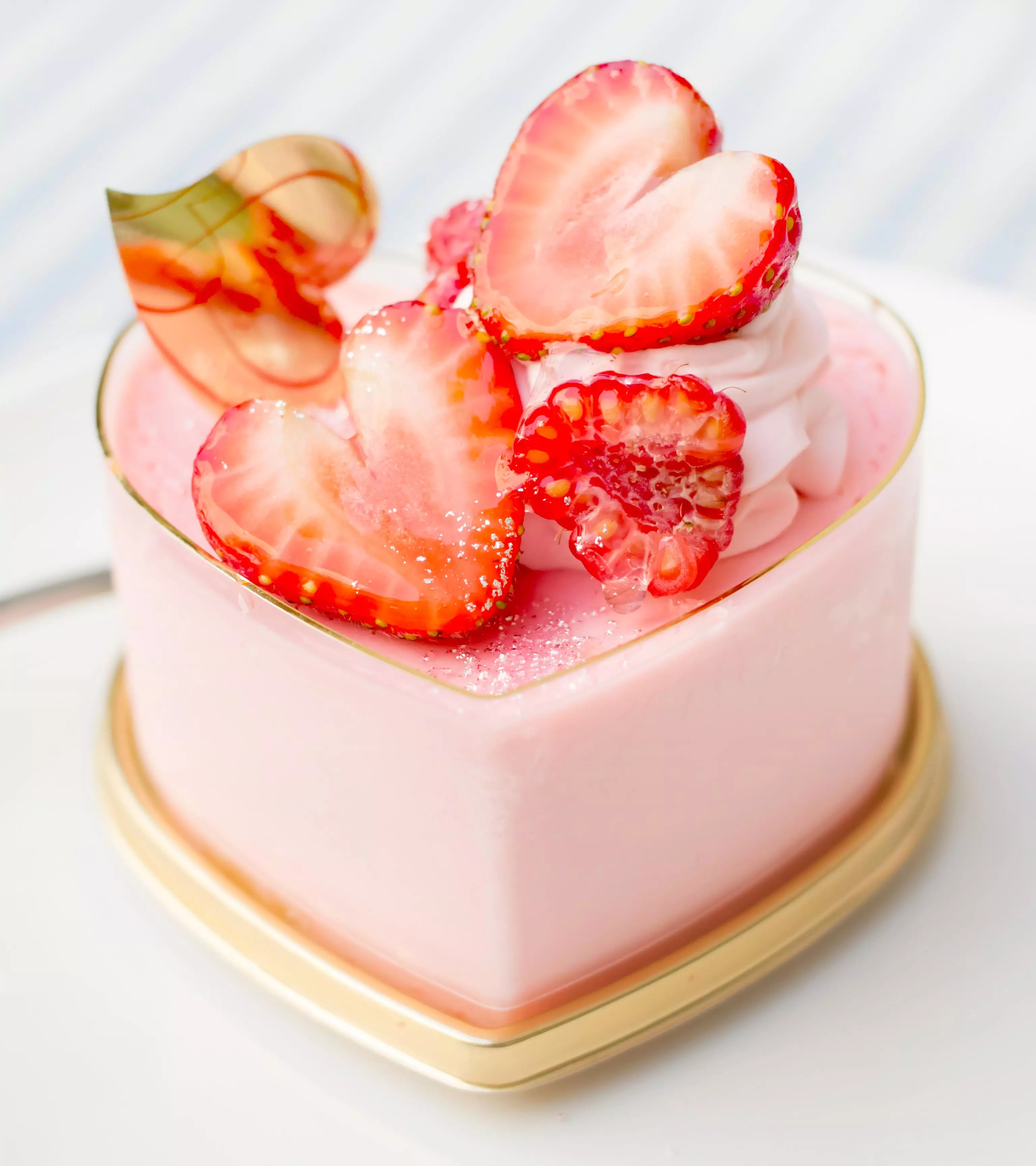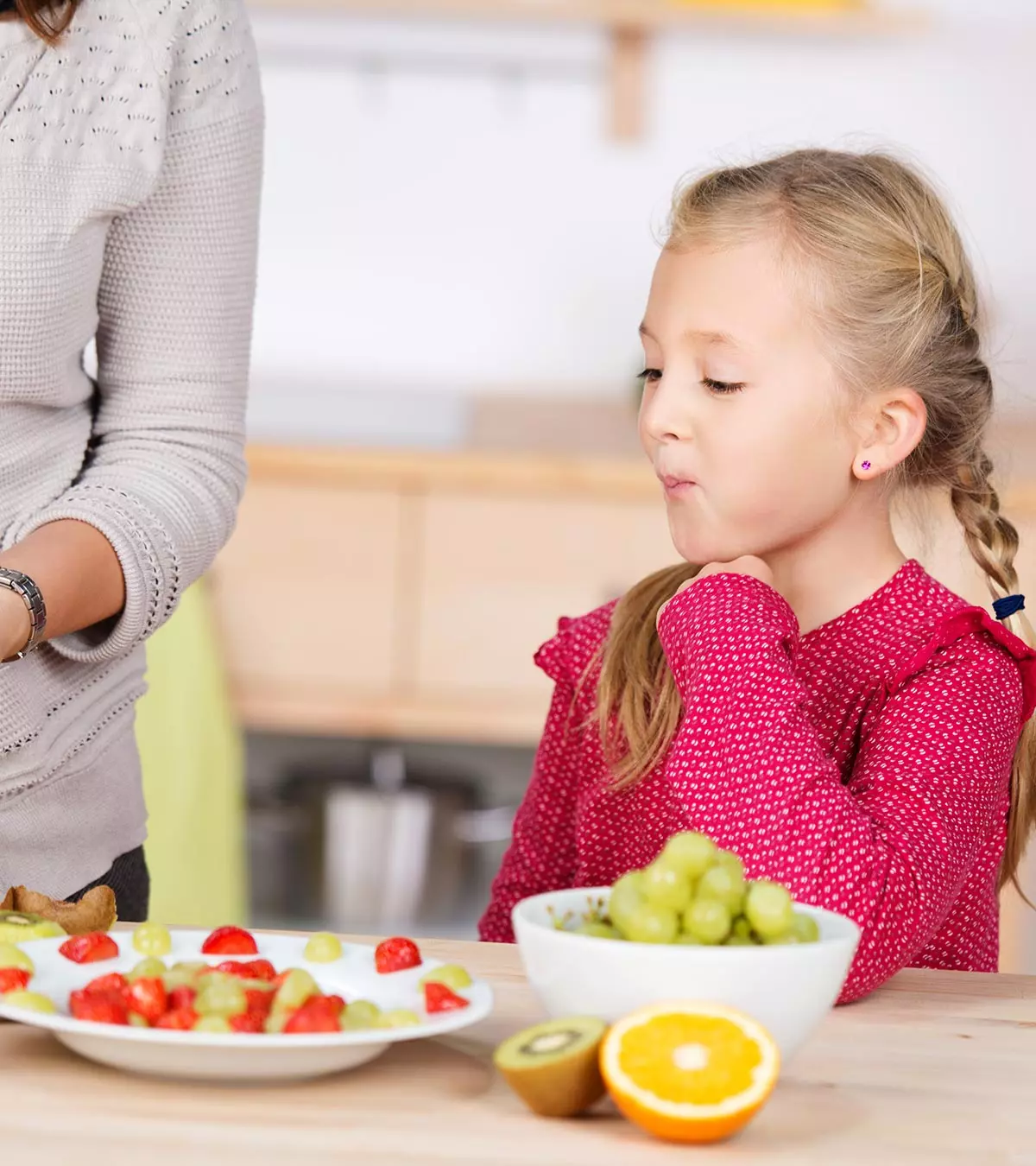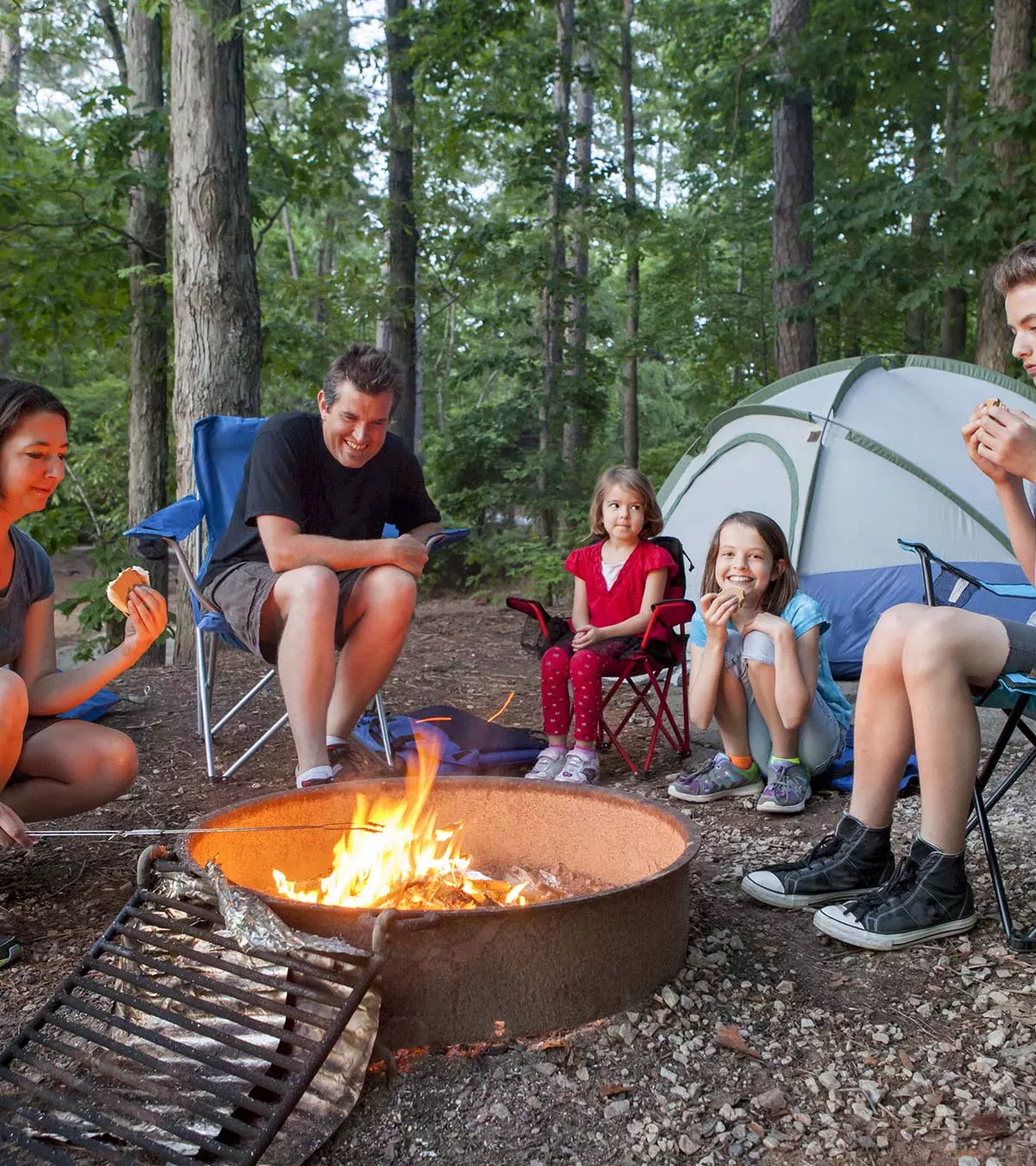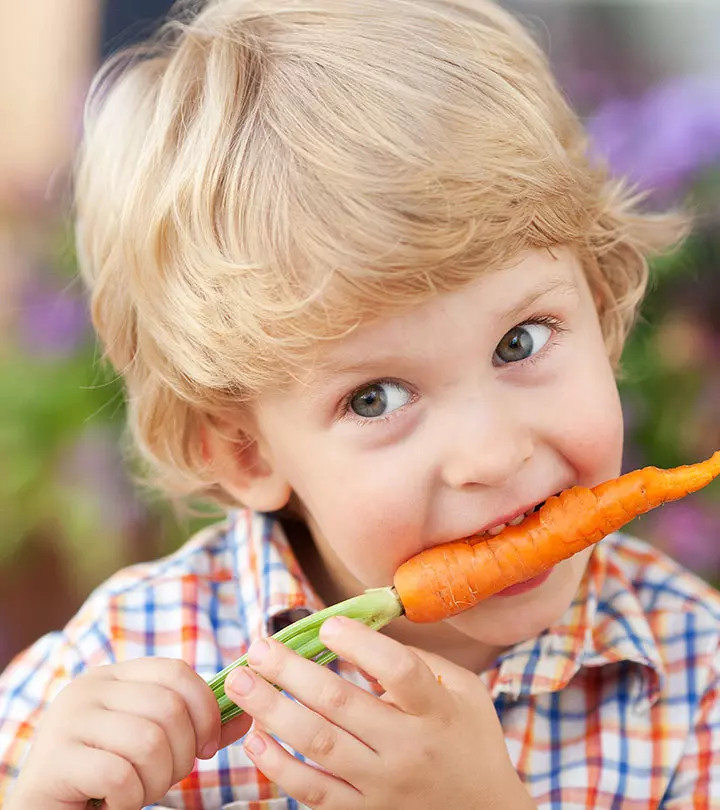
Image: Shutterstock
The benefits of bananas for kids are numerous as they are rich sources of calcium, potassium, magnesium, and several bioactive compoundsiMolecules in plants and some foods with antioxidant properties and health-promoting effects. that boosts children’s overall health.

Besides, it provides ample calories that can help contribute to a growing child’s increased energy needs.
The Cavendish banana is the most commonly consumed variety in the US and Europe (1). Since this all-season fruit is generally a favorite among children, it can be incorporated into different foods to prepare delectable dishes for children. While you may have been feeding bananas to your child for a while now, it’s not too late to learn more about the health benefits of this fruit.
This post shares some interesting facts about bananas, their health benefits for children, and 11 delightful banana recipes to try.
Key Pointers
- Banana is the only fruit containing essential amino acid tryptophan and vitamin B6, responsible for producing serotonin, a happy hormone.
- The fruit benefits your health by providing energy, boosting immunity, promoting bone health, and many other ways.
- For children with moderate activities, eating one or two bananas a day is sufficient.
- Explore ahead for easy and healthy banana recipes, such as banana and cashew pancakes, banana bread, and more.
Exciting Facts About Banana For Children
Here are some exciting banana facts that you can share with your child to ignite some curiosity about this fruit (2) (3) (4).
- On average, a banana weighs up to 125 grams, out of which 75 percent is water.
- Botanically, a banana is a berry that grows on an herb! Yes, the banana tree on which banana grows is botanically an herb distantly related to ginger.
- You might have seen a leaf float on water, but did you know that bananas can float too? Yes, bananas are less dense than water and can float on the surface just like apples
- A Cavendish banana contains as much potassium (400mg/100g of fresh fruit) as present in several cooked pulses, meat, and fish.
- Banana is a radioactive food, but it contains very little radioactivity to harm humans.
- Banana peels can help relieve itching and inflammation caused by a bug bite or poison ivy.
- Banana is the only fruit containing essential amino acid tryptophan and vitamin B6. These compounds facilitate the production of serotonin, a happy hormone that enhances the mood.
- There are more than 1000 varieties of bananas grown in about 150 countries in the world.
- Cavendish banana, a common banana type that we eat today, is different from the type of banana our ancestors ate. The Gros Michel, often known as “Big Mike’’, was the most common banana variety available before the 1960s that vanished due to Panama diseaseiA fungal disease of the banana that destroys the plant by restricting its water and nutrient supply from the soil. .
- The world’s most extensive collection devoted only to one fruit is the Banana Club Museum.
The list of exciting banana facts can be endless. As you now know some facts, let’s learn some crucial benefits of bananas your child could reap.
 Did you know?
Did you know?How Many Bananas Can A Child Eat Daily?
There isn’t a specific number of bananas that a child should eat daily. Usually, one to two bananas a day are sufficient for most moderately active children. Remember, moderation and variety is the key to a healthy balanced diet.
Health Benefits Of Banana For Children
Banana is an easy-to-digest, nutritious fruit.
Let’s learn how it supports your child’s health. Here are some of the noteworthy benefits of eating bananas as a part of a well-balanced diet.
- Provides energy: Banana is a sumptuous fruit that fills the tummy effectively. One ounce of banana (28g) offers about 94Kcal of energy which children can utilize to meet their daily energy needs (5). Children need energy for day-to-day activities and also growth and development.
- Supports digestion: One green banana (raw) is rich in insoluble dietary fiber that facilitates proper digestion. This insoluble fiber adds bulk to the diet and prevents constipation. Besides, it acts as a prebiotic that aids in the proper growth and development of probiotics that produce SCFAs (short-chain fatty acids) necessary to prevent chronic illnesses (1) (6) (7).
- Boosts immunity: Banana contains vital nutrients, such as vitamin C and B6, which support physiological functions that aid immunity. Additionally, it contains phytosterolsiPlant compounds that are beneficial in managing the body’s cholesterol levels. which also have immunomodulatoryiRelated to changes (either increase or decrease) in immunity. effects (8). Thus, banana consumption as a part of a balanced diet can help maintain a healthy immune system.
- Promotes bone and heart health: Banana contains a considerable amount of potassium and magnesium that support bone and heart health. These nutrients are also crucial to maintain the body’s electrolyte balance necessary to regulate vital body functions (9) (10).
- Enhances overall health: Bananas also contain bioactive compounds, such as phenolics, carotenoids, biogenic amines, and phytosterols. While phenolics and carotenoids combat free radical damage, biogenic amines and phytosterols regulate different physiological functions that boost overall health over time (11).
 Quick fact
Quick fact11 Tasty And Healthy Banana Recipes For Children
Bananas are pretty versatile and can be served mashed, chopped, sliced, or pureed. Here are 11 mouth-watering banana recipes that children of all ages can enjoy.
1. Banana and cashew pancakes
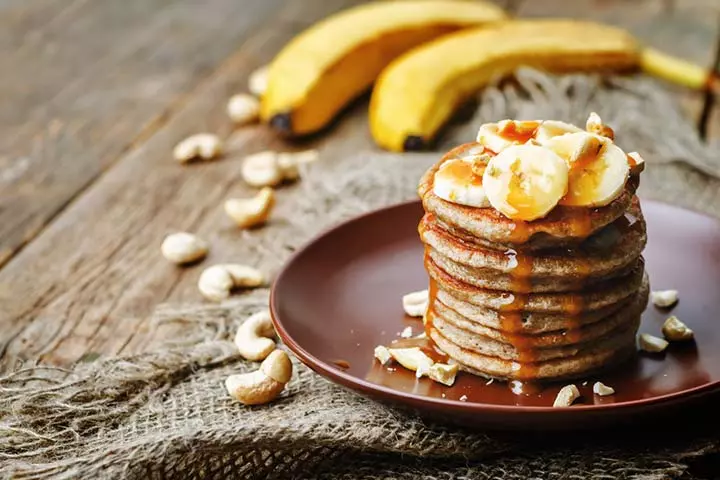
You will need:
- 1 cup whole wheat flour or almond flour (if you prefer gluten-free)
- ⅔ cup almond milk
- ½ cup mashed ripe banana
- ½ cup ripe banana (chopped)
- ½ cup olive oil
- 1 large egg
- 2tbsp honey or maple syrup
- 2tbsp unsalted butter
- 1tbsp baking powder
- ½ tsp cinnamon powder
- ½ tsp vanilla bean paste
- ¼ tsp salt
How to prepare:
- In a bowl, mix wheat flour, baking powder, cinnamon, and salt. Mix well and set the bowl aside.
- In another bowl, mix almond milk, butter, mashed banana, egg, maple syrup, and vanilla bean paste.
- Pour the almond milk mixture into the wheat flour mixture and mix everything thoroughly.
- Meanwhile, heat a skillet over medium-low heat.
- Once the skillet is hot, put a teaspoon of oil and spread it over the pan.
- Pour a tablespoon or two of the batter onto the skillet and cook each side for two to three minutes until golden brown.
- Serve warm with a tablespoon of almond or peanut butter and a cup of warm milk. You can also sprinkle some chopped, fresh fruits and mixed nuts to intensify your child’s nutrient intake.
This is an easy delectable dessert, including a banana for your tiny tot. You can also substitute maple syrup with honey for a more earthy sweetness. Alternatively, you can also make banana waffles and garnish them with some honey poured over them.
2. Banana bread
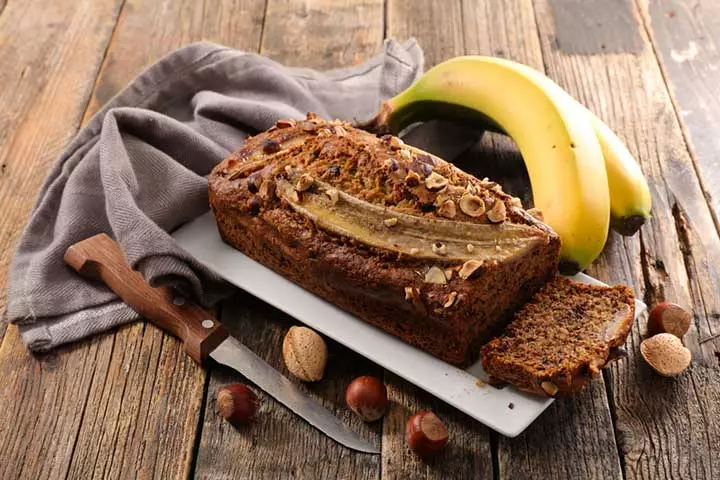
You will need:
- 2-3 ripe bananas (mashed)
- 1 large egg (beaten)
- 1½ cups all-purpose flour
- 1 cup nuts (almonds, walnut, and pine nuts; chopped)
- ¾ cup sugar
- ⅓ cup unsalted butter (melted)
- 1tsp baking soda
- 1tsp vanilla bean paste
- Pinch of salt
How to prepare:
- Preheat the oven to 350°F (175°C). Grease a loaf pan with oil or butter and set it aside.
- Meanwhile, in a mixing bowl, mix mashed bananas and melted butter.
- Stir in baking soda, salt, sugar, beaten egg, flour, chopped nuts, and vanilla bean paste. Mix everything well into a smooth-flowing, lump-free batter.
- Pour the batter into the loaf pan and bake for 50 minutes to an hour. Check doneness by inserting a toothpick into the loaf, which should come clean when the loaf is done.
- Remove the loaf pan from the oven and set it aside on the wire rack to cool.
- Serve a slice of freshly baked banana bread with scrambled egg, grilled veggies, and a cup of warm milk.
Describing how her selective-eater son enjoys the banana bread, Sandy Philpott, a mother, reveals, “My son tends to be something of a picky eater, but he recently discovered that he likes banana bread.” She adds that the recipe is simple, and even her six-year-old enjoys preparing it, “Start with three bananas; the browner, the better. This recipe is literally so easy a child can do it. My six-year-old needed a bit of guidance with measuring, and I managed the oven, but otherwise, he did it all himself, starting with peeling and mashing the bananas (i).”
 Quick tip
Quick tip3. Baked banana chips
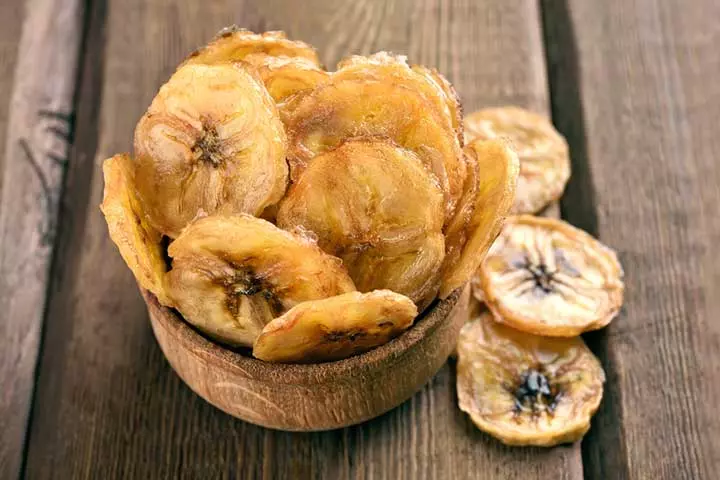
You will need:
- 2 raw banana (peeled and thinly sliced)
- ½ tbsp paprika powder
- ¼ tbsp black pepper powder
- Salt, to taste
- Olive oil for coating and greasing
How to prepare:
- Preheat the oven to 392°F (200°C) for about ten minutes. Line a baking tray with parchment paper and set it aside.
- In a mixing bowl, add sliced banana, paprika powder, black pepper powder, salt, and a few olive oil drops. Mix well until the banana slices coat well.
- Place the banana slices on the baking tray and bake for 20 to 25 minutes until they become golden and crisp.
- Serve warm baked banana chips as snacks along with a dip of your choice and a cup of fresh lemonade.
4. Gooey oatmeal and banana bites
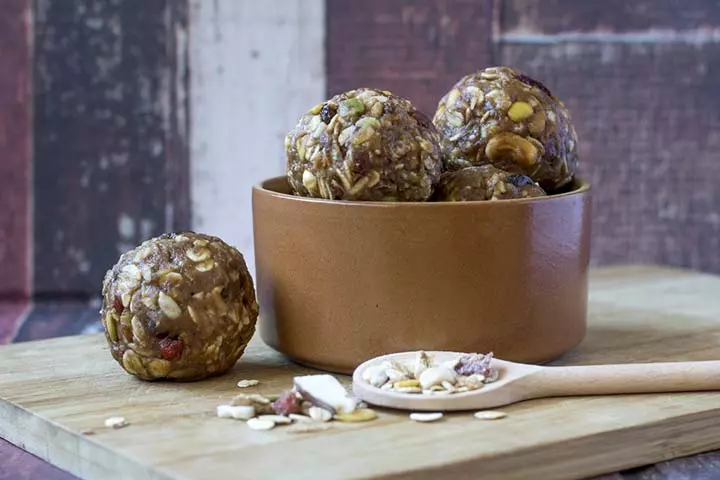
You will need:
- 2½ cups rolled oats
- 1 cup ripe banana (mashed)
- ¼ cup peanut butter
- ¼ cup seeds and nuts trail mix
- 2tbsp organic honey
- 1tsp cinnamon powder
How to prepare:
- Place all the ingredients in a bowl and mix them well into a homogenous mixture.
- Take two to three tablespoons of the mixture between your palms and roll into round balls.
- Once the balls are ready, place them on a plate and refrigerate covered for two to three hours.
- Serve two to three balls with a cup of milk and pack the remaining in an airtight container. Keep in the refrigerator for up to a month.
5. Oats banana cookies

You will need:
- 3 cups rolled oats
- 1½ cup brown sugar
- 1½ cup all-purpose flour
- 1 cup mashed bananas
- 1 cup nuts and seeds mix
- ¾ cup unsalted butter (melted)
- 1 egg
- 2tsp corn starch
- 1½tsp cinnamon powder
- 1tsp vanilla bean paste
- 1tsp baking soda
- ¼ tsp ground cloves
How to prepare:
- Preheat the oven to 350°F (177°C). Line a baking tray with parchment paper and set it aside.
- Meanwhile, put butter, brown sugar, egg, vanilla bean paste, and mashed bananas in a bowl and mix well until everything is combined.
- Stir in flour, cinnamon powder, baking soda, cloves, oats, and corn starch. Mix well to form a soft yet crumbly dough.
- Place the dough on the kitchen counter or flat board and roll it out into a thick sheet using a roller pin.
- Cut circular cookies from this dough using a cookie cutter and place them on the baking tray.
- Bake for ten to 12 minutes until the edges turn golden.
- Remove from the oven and put the baking tray on the wire rack to cool.
- Serve with milk or let your child eat them as a quick, healthy snack.
6. Banana choco smoothie

You will need:
- 1 banana (frozen and chunked)
- 1 cup soy milk
- 1 cup vanilla-flavored yogurt
- 4tbsp unsweetened dark chocolate (powdered)
How to prepare:
- Blend banana chunks, chocolate powder, soy milk, and vanilla yogurt into a smooth-flowing, creamy liquid.
- Pour it into a glass and serve topped with toasted nuts and seeds.
- You can also add ice cream instead of yogurt to make a variant of the recipe.
This is a flavorful banana juice for your little one to give him the energy to sustain all day.
7. Banana muffins

You will need:
- 1½ cup all-purpose flour
- 1 cup mixed nuts (almonds, cashew, and pistachio; chopped)
- ⅔ cup dark brown sugar
- 2 ripe banana (mashed)
- 1 large egg
- 4tbsp unsalted butter
- 2tbsp milk
- 1tsp baking powder
- 1tsp baking soda
- 1tsp cinnamon powder
- ½ tsp salt
- ¼ tsp nutmeg powder
How to prepare:
- Preheat the oven to 425°F (218°C). Grease a muffin tin with butter or line with paper liners.
- In a mixing bowl, mix flour, baking powder, baking soda, salt, cinnamon, and nutmeg. Set the bowl aside.
- In a separate bowl, beat or whisk the melted butter with brown sugar, egg, nuts, and milk.
- Pour the dry ingredients into the wet ingredients, and mix well until everything is well-combined.
- Fill each mold in the muffin tin to their brim with the batter. Bake for five minutes, and then reduce the temperature to 350°F (177°C).
- Bake the muffins for an additional 16 to 18 minutes until they turn puffed up and brown.
- Serve a muffin or two as an afterschool or on-the-go snack. Store the remaining in an airtight container in the refrigerator for up to a month.
Alternatively, instead of pouring the mix into a muffin tin, you can bake it into a cake tin. It would be a good banana cake that the whole family can relish.
8. Banana frozen yogurt

You will need:
- 1 cup unsweetened Greek yogurt
- ½ cup chopped nuts
- 2 banana (mashed)
- 1tbsp peanut butter
- 1tsp cinnamon powder
- 1tsp pumpkin seeds (chopped)
How to prepare:
- Blend the banana, peanut butter, and cinnamon into a smooth puree.
- Stir in nuts, seeds, and yogurt into the banana puree and mix well.
- Freeze for four to six hours until set. Serve chilled with a drizzle of hot chocolate and chopped fresh fruits.
9. Banana ice cream
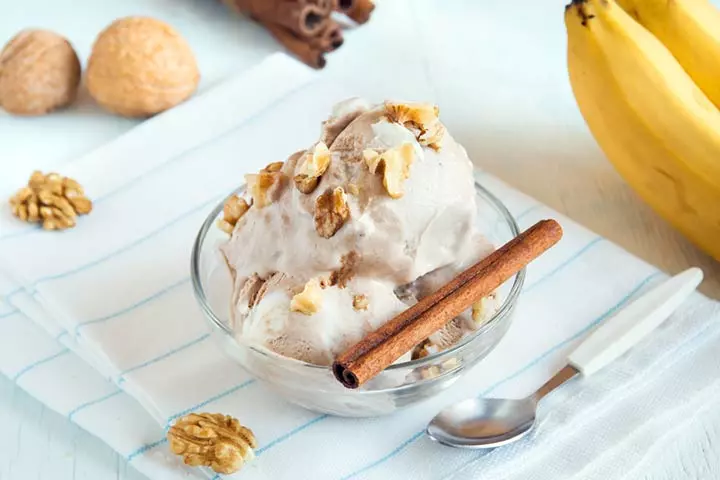
You will need:
- 2 frozen banana
- ½ cup mango and strawberry (chopped)
- 1tbsp nuts (chopped)
- 1tbsp brown sugar
- 1tsp vanilla bean paste
How to prepare:
- Blend a frozen banana, mango, and strawberry into a thick paste using a blender.
- Add vanilla bean paste and brown sugar. Blend again to mix everything well.
- Pour the mixture into an airtight container and freeze for about three to four hours.
- Put some ice cream into a serving bowl and garnish it with nuts. Serve.
10. Refreshing banana and coconut drink

You will need:
- 1 banana (chopped)
- 1 cup almond milk or coconut milk (to intensify coconut flavour)
- ½ cup fresh coconut slices
- 3tbsp brown sugar
- Few ice cubes
How to prepare:
- Put a pan on low heat. Add water and sugar and cook until you get thick, light brown syrup.
- Add banana pieces to the syrup and mix thoroughly. Cook on low flame for about a minute and transfer into a bowl. Set aside.
- Take a wide-bottom serving glass and add coconut slices in one layer. Pour banana and sugar syrup over it and at last pour almond milk.
- Serve chilled with a club sandwich or quinoa salad.
11. Chocolate banana popsicles

You will need:
- 3 bananas
- 1 cup milk
- 2tbsp cocoa powder
- ⅓ cup maple syrup or any other natural sweetener
How to prepare:
1. Slice one banana into thin rounds. Place two to three slices into each popsicle mold.
2. Put the remaining banana and the rest of the bananas into the blender. Add cocoa powder, maple syrup, and milk to the mix.
3. Blend everything together until you get a smooth batter.
4. Take the blended mixture and pour it into the molds with the banana slices. Make sure they are evenly distributed.
5. Pop the molds in the freezer for 4-5 hours or overnight until the popsicles are completely set.
6. Once frozen, take them out, and serve.
In addition to these recipes, you can include bananas in the diet in several other ways. For example, you can cut the fruit into small round pieces and add it to your little one’s cereal in the morning. You can buy banana-flavored jams and spread them on whole-grain bread toast. You can try making banana pie or pudding and garnish it with bread crumbles for a healthy dessert. To make it more interesting, adding bananas to the parfait could also be one way to incorporate this fruit into your kid’s diet.
Frequently Asked Questions
1. What is the best time to give bananas to kids?
Bananas are best consumed in the morning, as they can be included in many delicious breakfast recipes. Children may also consume them as snacks after a tiring game session. It is generally advised to avoid giving bananas to children at night since it might increase mucus secretion. However, evidence regarding this claim is limited. Hence, confirm with your pediatrician if your child can have bananas at night.
2. What are the side effects of consuming bananas?
Bananas are primarily safe for consumption and rarely cause much discomfort. Signs of a banana allergy may include itching, rashes, narrowing of the throat, and wheezing (12).
3. What age group is appropriate for kids to start eating bananas?
Children may start eating bananas between the ages of six to eight months when they begin their solid food diet (15). However, feed them in moderation and after consulting your pediatrician, as bananas sometimes cause constipation (16).
4. What are some tips for choosing the best bananas for children?
When choosing bananas for children, pick the ones that are naturally ripened over the ones that are artificially ripened, as the latter contains chemicals. The naturally ripened ones will have a uniform dark yellow color, whereas the artificially ripened ones will have a green tip and a lighter yellow color. You may also taste one and choose the bunch that tastes sweeter and has a softer texture. Avoid the ones covered in dark spots, as it indicates the fruit inside may be bruised.
5. Do bananas cause constipation?
Ripe bananas have a high fiber content that helps in digestion and proper bowel movements. However, unripe bananas may lead to constipation, as they have higher insoluble fiber content.
Fruits like bananas are considered healthy foods for kids. One or two bananas for kids daily can be beneficial. Banana is packed with essential vitamins and minerals such as vitamin B6, potassium, calcium, and some essential amino acids. It helps improve immunity, boosts bone and heart health, and provides energy. There are no specific recommendations to limit the number of bananas in a child’s diet. However, considering the calories, it is better to consume in moderation for moderately active children. Bananas can be consumed directly, or you may try recipes such as pancakes, banana milkshakes, cookies, bread, or chips.
Infographic: Tasty And Healthy Banana Recipes For Children
Discover the ultimate collection of delicious and nutritious banana recipes to captivate your children’s taste buds. From smoothies and pancakes to muffins and popsicles, this infographic presents a variety of easy-to-make treats that are not only scrumptious but also packed with essential vitamins and minerals.
Some thing wrong with infographic shortcode. please verify shortcode syntaxIllustration: Banana For Kids: Fun Facts Benefits And 10 Easy Recipes

Image: Dall·E/MomJunction Design Team
Discover the surprising history of bananas! From their ancient origins to their modern-day popularity, explore the fascinating story of this beloved fruit in this informative video.
Personal Experience: Source
MomJunction articles include first-hand experiences to provide you with better insights through real-life narratives. Here are the sources of personal accounts referenced in this article.
i. Easy banana bread for kids;https://sandysmotherhoodblog.blogspot.com/2016/02/easy-banana-bread-for-kids.html
References
1. Bananas; Harvard T.H Chan
2. 8 things you didn’t know about bananas; PBS
3. Banana facts and figures; FAO, UN
4. All about bananas: things you should know about the tropical fruit; FAO, UN
5. [HISTORICAL RECORD]: BANANA, FDC ID: 362759; Food Data Central; USDA
6. Ana Luisa Falcomer et al.; Health Benefits of Green Banana Consumption: A Systematic Review; NCBI
7. Tanvi Shinde et al.; Synbiotic supplementation with prebiotic green banana resistant starch and probiotic Bacillus coagulans spores ameliorates gut inflammation in mouse model of inflammatory bowel diseases; Springer Link
8. Amir Amini Khoozani et al.; Production, application and health effects of banana pulp and peel flour in the food industry; NCBI
9. Fruit of the month: Bananas; Harvard Health Publishing
10. Food and Your Bones — Osteoporosis Nutrition Guidelines; National Osteoporosis Foundation
11. Balwinder Singh et al.; Bioactive compounds in banana and their associated health benefits – A review; NCBI
12. Banana; Anaphylaxis Campaign
13. Apples and oranges are the top U.S. fruit choices; USDA
14. Noreen Samad, et al.; Banana fruit pulp and peel involved in antianxiety and antidepressant effects while invigorate memory performance in male mice: Possible role of potential antioxidants; NCBI
15. Feeding patterns and diet – children 6 months to 2 years; Mount Sinai
16. Starting Solid Foods; Benioff Children’s Hospital
Community Experiences
Join the conversation and become a part of our nurturing community! Share your stories, experiences, and insights to connect with fellow parents.
Read full bio of Shivani Sikri
Read full bio of Swati Patwal
Read full bio of Rohit Garoo
Read full bio of Shinta Liz Sunny









